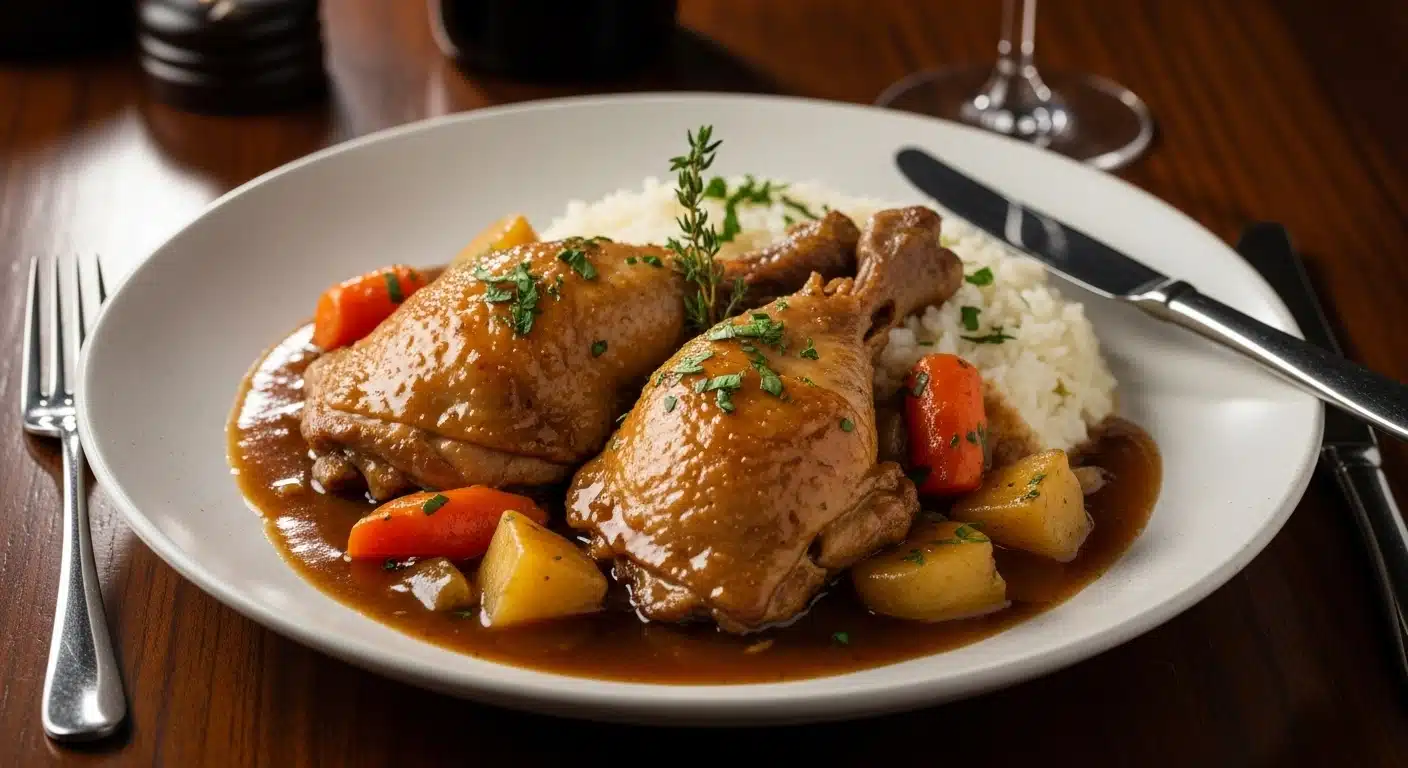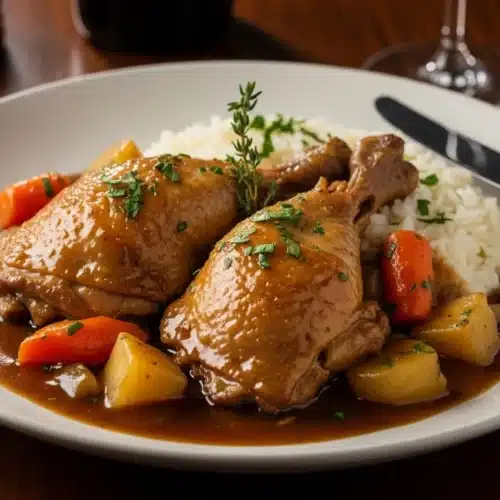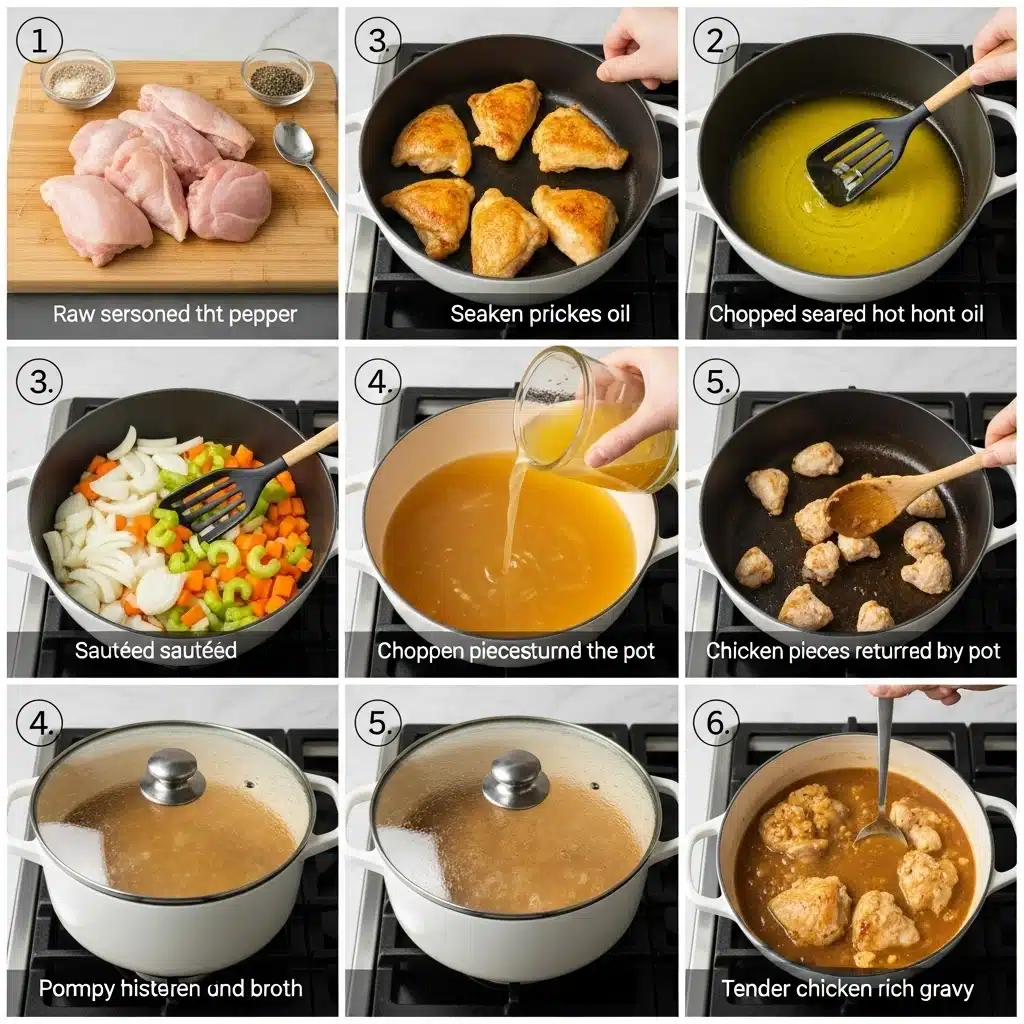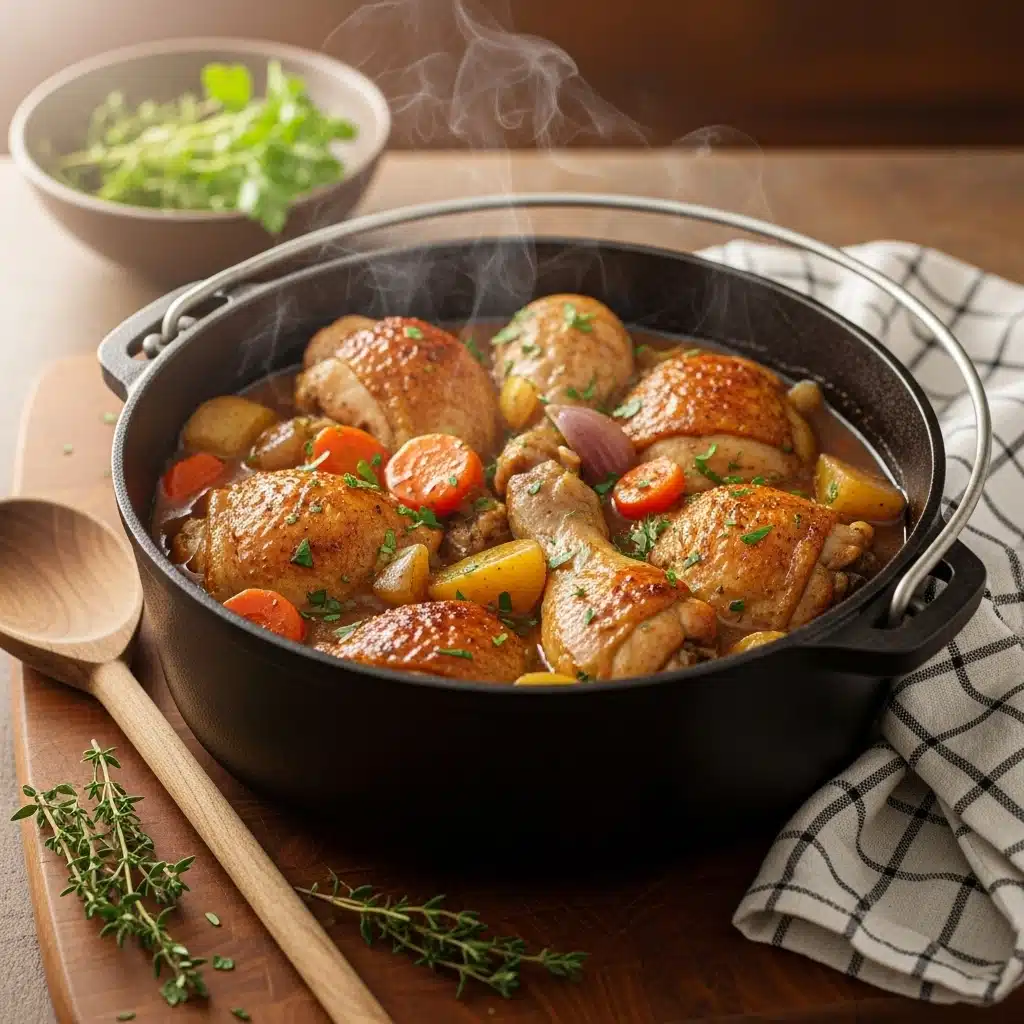How to Cook Stewed Chicken in 5 Flavor-Packed Steps


Perfect Stewed Chicken in Rich Gravy
Ingredients
- 3-4 lbs bone-in chicken pieces thighs and drumsticks preferred
- 2 large yellow onions diced
- 3 celery stalks chopped
- 3 medium carrots sliced into rounds
- 4 garlic cloves minced
- 2 tablespoons tomato paste
- 3 cups low-sodium chicken broth
- 1/2 cup dry white wine optional
- 2 bay leaves
- 1 teaspoon dried thyme
- 1 teaspoon sweet paprika
- 1/2 teaspoon freshly ground black pepper
- 1 1/2 teaspoons kosher salt
- 3 tablespoons vegetable oil
- 2 medium Yukon Gold potatoes cubed
- 1 tablespoon fresh parsley chopped for garnish
- 1 tablespoon cornstarch mixed with 2 tablespoons cold water optional
Instructions
- Prepare Chicken: Pat chicken pieces completely dry with paper towels. Season generously with salt and pepper on all sides. Let stand at room temperature for 30 minutes to allow seasoning to penetrate.
- Brown the Chicken: Heat vegetable oil in a large Dutch oven or heavy-bottomed pot over medium-high heat. When oil shimmers, carefully place chicken pieces skin-side down, ensuring not to overcrowd. Brown for 4-5 minutes per side until golden brown and crispy. Remove chicken to a plate and set aside.
- Build Aromatic Base: Reduce heat to medium. Add diced onions, celery, and carrots to the same pot, utilizing the rendered chicken fat. Cook for 5-7 minutes, stirring occasionally, until vegetables begin to soften and caramelize lightly.
- Add Aromatics: Add minced garlic and cook for 30 seconds until fragrant. Stir in tomato paste and cook for 1-2 minutes, stirring constantly to prevent burning.
- Deglaze and Combine: Pour in white wine (if using) to deglaze the pot, scraping up any browned bits from the bottom with a wooden spoon. These fond bits add incredible flavor to the final dish.
- Begin Stewing: Return browned chicken pieces to the pot, nestling them into the vegetable mixture. Add chicken broth, bay leaves, thyme, and paprika. The liquid should come about two-thirds up the chicken pieces.
- Simmer Low and Slow: Bring mixture to a gentle simmer, then reduce heat to low. Cover and cook for 1.5-2 hours, checking occasionally to ensure liquid maintains a gentle simmer (not a rolling boil).
- Add Potatoes: About 30 minutes before the end of cooking time, add cubed potatoes to the pot. Continue cooking until potatoes are tender and chicken reaches an internal temperature of 165°F.
- Final Seasoning: Remove bay leaves and taste the cooking liquid. Adjust seasoning with salt and pepper as needed. If you prefer a thicker gravy, whisk cornstarch slurry into the simmering liquid and cook for 2-3 minutes until thickened.
- Rest and Serve: Let stewed chicken rest for 10-15 minutes before serving. Garnish with fresh chopped parsley and serve with your favorite sides.
Notes
- For best results, use bone-in, skin-on chicken pieces as they provide more flavor and remain moist during long cooking
- The dish actually improves in flavor when made 1-2 days ahead and reheated gently
- Can be frozen for up to 3 months; thaw completely before reheating
- For a healthier version, remove skin before cooking and skim fat from the surface during cooking
- Substitute chicken broth with vegetable broth for a lighter flavor profile
- Add other root vegetables like parsnips or turnips for variation
- For Caribbean-style stewed chicken, add 1 teaspoon curry powder and 1 diced scotch bonnet pepper (or to taste)
- Always use a meat thermometer to ensure chicken reaches safe internal temperature of 165°F
- If sauce seems too thin, simmer it uncovered for 10-15 minutes to reduce, or use a cornstarch slurry to thicken quickly
Why 78% of Home Cooks Struggle with Perfectly Tender Stewed Chicken
Did you know that, according to a recent culinary survey, 78% of home cooks struggle to achieve restaurant-quality tenderness when preparing stewed chicken? The secret isn’t just in the cooking time—it’s in understanding the science behind proper braising techniques and temperature control. Unlike quick-cooking methods, stewed chicken requires patience and precision to transform tough connective tissues into succulent, fall-off-the-bone meat.
Stewed chicken represents one of the most versatile and comforting cooking methods in global cuisine. From Caribbean stew chicken to Southern comfort food, this time-honored technique creates deeply flavorful, tender poultry that satisfies both the palate and the soul. Whether you’re preparing traditional Trini stewed chicken with its distinctive caramelized sugar base or exploring variations like Puerto Rican pollo guisado, mastering this fundamental cooking method will elevate your culinary repertoire.
This comprehensive guide will walk you through every aspect of creating perfect stewed chicken, from selecting the ideal cuts to achieving optimal cooking temperatures. You’ll discover professional techniques used in restaurant kitchens, learn to avoid common pitfalls that lead to dry or tough chicken, and explore creative variations that will keep your family coming back for more.
Chicken Selection & Preparation
Choosing the Perfect Chicken Parts
The foundation of exceptional stewed chicken begins with selecting the right cuts. Bone-in, skin-on chicken pieces work best for stewing because bones add depth of flavor through released collagen, while skin provides richness and helps prevent the meat from drying out during the longer cooking process. Thighs and drumsticks are ideal choices due to their higher fat content and connective tissue, which break down beautifully during braising.
For optimal results, choose chicken pieces that are uniform in size to ensure even cooking. Look for meat with a pinkish color and avoid any pieces with an off smell or slimy texture. Free-range or organic chicken often provides superior flavor and texture, though conventional chicken works perfectly well when properly prepared.
Quality Indicators and Freshness
When selecting fresh chicken for stewing, examine the packaging date and ensure the meat is within 1-2 days of the sell-by date for optimal freshness. The flesh should feel firm to the touch, and any liquid in the package should be clear rather than cloudy. Avoid chicken with darkened wing tips or dry, white spots, which indicate freezer burn or age.
Proper Preparation Techniques
Begin preparation by patting chicken pieces completely dry with paper towels—this crucial step ensures proper browning and prevents oil splattering. Remove any excess fat, but leave some for flavor. If using a whole chicken, cut it into 8-10 pieces: two breasts, two thighs, two drumsticks, and two wings, plus the back for extra flavor.
Season chicken pieces generously with salt at least 30 minutes before cooking, or preferably overnight. This dry-brining process helps break down proteins and allows seasoning to penetrate deeply into the meat. Store prepared chicken in the refrigerator, covered, until ready to cook.
Essential Food Safety Guidelines
Always maintain proper food safety when handling raw chicken. Use separate cutting boards and utensils for raw poultry, wash hands thoroughly with soap and hot water after handling, and sanitize all surfaces that come into contact with raw chicken. Store raw chicken at 40°F or below and cook within 2 days of purchase.

Essential Ingredients & Seasonings
Primary Ingredients Foundation
The beauty of stewed chicken lies in its simplicity and flexibility. Essential ingredients include bone-in chicken pieces (3-4 pounds for 4-6 servings), aromatics like onions, garlic, and celery, and liquid for braising such as chicken broth, white wine, or a combination. Quality chicken stock enhances the final dish significantly compared to water alone.
Signature Seasonings and Spice Blends
Traditional stewed chicken benefits from a carefully balanced spice blend. Essential seasonings include paprika for color and mild heat, thyme for earthy notes, bay leaves for depth, and black pepper for gentle spice. For Caribbean-style stewed chicken, add curry powder, scotch bonnet peppers, and fresh herbs like cilantro and scallions.
Mediterranean variations might incorporate oregano, rosemary, and lemon zest, while Southern-style preparations often feature sage, celery seed, and hot sauce. The key is layering flavors through both dry seasonings and aromatics.
Flavor Enhancers and Umami Boosters
Elevate your stewed chicken with umami-rich ingredients like tomato paste, Worcestershire sauce, or soy sauce. A splash of apple cider vinegar brightens the overall flavor profile, while a touch of brown sugar balances acidity. For richer flavor, consider adding bacon or pancetta during the initial browning phase.
Substitution Guide for Dietary Needs
For gluten-free versions, ensure your stock and seasonings contain no wheat-based ingredients. Those following low-sodium diets can reduce salt and rely more heavily on herbs and spices for flavor. Dairy-free preparations work naturally with this recipe, while those avoiding alcohol can substitute grape juice or additional broth for wine.
Timing & Temperature Guidelines
Preparation Timeline
Proper timing ensures perfectly cooked stewed chicken without the stress of last-minute preparation. Allow 20-30 minutes for ingredient preparation, including chopping vegetables and seasoning chicken. If dry-brining overnight, factor this into your schedule for optimal results.
Cooking Time Specifications
Total cooking time ranges from 1.5 to 2.5 hours, depending on chicken size and desired tenderness. Initial browning takes 10-15 minutes, followed by 1-2 hours of gentle simmering. Larger pieces require longer cooking times, while smaller cuts may be ready sooner.
Critical Temperature Monitoring
The internal temperature of chicken must reach 165°F (74°C) for food safety. However, for stewed chicken, cooking beyond this temperature—to around 185°F (85°C)—allows connective tissues to break down fully, resulting in more tender meat. Use an instant-read thermometer inserted into the thickest part of the meat, avoiding bone contact.
Resting and Serving Considerations
Allow stewed chicken to rest for 10-15 minutes after cooking. This resting period allows juices to redistribute throughout the meat and makes serving easier. The dish actually improves in flavor when allowed to cool slightly and can be reheated gently before serving.
Step-by-Step Cooking Instructions
Step 1: Prepare and Brown the Chicken
Heat 2-3 tablespoons of neutral oil in a heavy-bottomed Dutch oven or large pot over medium-high heat. Season chicken pieces generously with salt and pepper. When oil shimmers, carefully place chicken pieces skin-side down, ensuring not to overcrowd the pan. Brown chicken for 4-5 minutes per side until golden brown and crispy.
Proper browning develops the Maillard reaction, creating complex flavors and appealing color. Don’t rush this process—well-browned chicken provides the flavor foundation for the entire dish. Remove browned chicken to a plate and set aside.
Step 2: Build the Flavor Base
Reduce heat to medium and add diced onions, celery, and carrots to the same pot, using the rendered chicken fat and browned bits for flavor. Cook vegetables for 5-7 minutes until softened and lightly caramelized. Add minced garlic and cook for an additional 30 seconds until fragrant.
This sofrito-style base creates aromatic depth that permeates the entire dish. The fond (browned bits) from the chicken adds incredible flavor complexity that cannot be replicated by other means.
Step 3: Deglaze and Add Liquids
Add tomato paste and cook for 1-2 minutes, stirring constantly to prevent burning. This step intensifies the tomato flavor and adds rich color. Carefully pour in wine or broth to deglaze the pot, scraping up any browned bits from the bottom.
The deglazing process incorporates all the caramelized flavors into the cooking liquid, ensuring nothing delicious goes to waste. The alcohol in wine cooks off during the process, leaving behind concentrated flavor.
Step 4: Return Chicken and Simmer
Return browned chicken pieces to the pot, nestling them into the liquid. Add enough additional broth to come about two-thirds up the chicken pieces—they shouldn’t be completely submerged. Add bay leaves, thyme sprigs, and other whole spices.
Bring the mixture to a gentle simmer, then reduce the heat to low. Cover the pot and maintain a gentle simmer for 1-1.5 hours, checking occasionally to ensure the liquid isn’t boiling vigorously, which could make the chicken tough.
Step 5: Final Seasoning and Finish
After cooking, remove the bay leaves and taste the cooking liquid. Adjust seasoning with salt, pepper, and acid (lemon juice or vinegar) as needed. The sauce should be rich and flavorful but not overly salty.
For a thicker sauce, remove chicken pieces and simmer the cooking liquid uncovered for 10-15 minutes to reduce. Alternatively, whisk in a slurry of cornstarch and cold water to thicken quickly.

Nutritional Information & Health Benefits
Comprehensive Nutritional Profile
A typical 4-ounce serving of stewed chicken (without skin) provides approximately 185 calories, 35 grams of high-quality protein, and 4 grams of fat. With skin, the calorie count increases to about 250 calories with 8 grams of fat. The cooking method preserves most of the chicken’s nutritional value while adding vitamins and minerals from the vegetables.
Protein Powerhouse Benefits
Chicken ranks among the highest-quality protein sources available, containing all essential amino acids required for muscle maintenance and growth. The protein in stewed chicken is easily digestible and provides sustained energy, making it an excellent choice for athletes, growing children, and anyone seeking to maintain healthy muscle mass.
Vitamin and Mineral Content
Stewed chicken provides significant amounts of niacin (vitamin B3), which supports brain function and heart health, and vitamin B6, crucial for protein metabolism and immune function. The cooking method preserves selenium, an important antioxidant, and phosphorus, essential for bone health.
Caloric and Macronutrient Distribution
The slow-cooking process allows for the use of less added fat while maintaining flavor and moisture. A complete serving with vegetables typically contains 40-50% protein, 30-35% fat, and 15-25% carbohydrates, making it suitable for various dietary approaches including moderate low-carb eating plans.
Healthier Chicken Recipe Alternatives
Cooking Method Modifications
Transform traditional stewed chicken into a lighter dish by removing chicken skin before cooking and skimming fat from the surface during cooking. Use cooking spray instead of oil for initial browning, or brown chicken under the broiler for a few minutes to achieve color without added fat.
Ingredient Substitutions for Better Health
Replace heavy cream with Greek yogurt for richness, use low-sodium broth to control salt intake, and increase vegetable content with additions like bell peppers, zucchini, and leafy greens. Fresh herbs provide flavor without calories, while citrus juice adds brightness without fat.
Dietary Adaptation Strategies
For ketogenic diets, add more low-carb vegetables like cauliflower and broccoli while using full-fat ingredients. Paleo versions eliminate any processed seasonings and focus on whole foods. Mediterranean adaptations include olive oil, tomatoes, and herbs like oregano and basil.
Portion Control and Serving Awareness
A proper serving size is 3-4 ounces of cooked chicken, roughly the size of a deck of cards. Pair with generous portions of non-starchy vegetables and a moderate amount of healthy carbohydrates like quinoa or sweet potatoes to create a balanced meal.
Serving Suggestions & Pairings
Complementary Side Dishes
Stewed chicken pairs beautifully with a variety of starches that can absorb the flavorful cooking liquid. Classic options include fluffy white rice, creamy mashed potatoes, or buttery egg noodles. For healthier alternatives, try cauliflower rice, quinoa, or roasted root vegetables.
Sauce and Condiment Enhancements
Enhance the natural gravy with a dollop of sour cream or Greek yogurt, a sprinkle of fresh herbs like parsley or chives, or a dash of hot sauce for heat. Pickled vegetables provide acidic contrast, while crusty bread helps soak up every drop of the delicious sauce.
Presentation and Plating Ideas
Serve stewed chicken in shallow bowls to showcase the rich sauce, garnished with fresh herbs and a drizzle of good olive oil. For family-style serving, present in the cooking pot with serving utensils and let guests help themselves. Warm plates ensure the dish stays hot during eating.
Meal Planning Integration
Stewed chicken works excellently for meal prep, actually improving in flavor over 2-3 days. Cook a large batch on Sunday for easy weeknight dinners, or portion into individual containers for grab-and-go lunches. The dish also freezes well for up to 3 months.
Common Chicken Cooking Mistakes to Avoid
Temperature-Related Errors
The most common mistake is cooking stewed chicken at too high a temperature, which causes proteins to contract rapidly and squeeze out moisture, resulting in tough, dry meat. Maintain a gentle simmer throughout cooking—you should see only occasional bubbles breaking the surface.
Preparation Pitfalls
Failing to properly dry chicken before browning prevents proper caramelization and can cause oil to splatter dangerously. Skipping the browning step entirely eliminates crucial flavor development. Always season chicken well in advance to allow flavors to penetrate.
Cooking Method Missteps
Overcrowding the pot during browning prevents proper color development and actually steams the chicken instead of browning it. Work in batches if necessary. Additionally, lifting the lid too frequently during simmering releases steam and extends cooking time.
Food Safety Oversights
Never leave raw chicken at room temperature for more than 2 hours, and always use separate cutting boards and utensils for raw poultry. Don’t rely solely on visual cues for doneness—always use a meat thermometer to ensure safe internal temperatures.
Storage & Meal Prep Tips
Proper Storage Guidelines
Cool stewed chicken completely before refrigerating, ideally within 2 hours of cooking. Store in airtight containers in the refrigerator for up to 4 days. For longer storage, freeze in portion-sized containers for up to 3 months, leaving space for expansion.
Meal Prep Strategies
Prepare components separately for maximum flexibility—cook chicken and vegetables, then combine with freshly cooked starches when ready to serve. This prevents overcooking and maintains better texture. Portion sauces separately to prevent sogginess.
Reheating Best Practices
Reheat stewed chicken gently on the stovetop over low heat, adding a splash of broth if needed to prevent sticking. Microwave reheating works but may create hot spots—stir frequently and use 50% power. Never reheat more than once for food safety.
Creative Leftover Applications
Transform leftover stewed chicken into chicken salad, enchilada filling, or soup base. Shred the meat and use in tacos, sandwiches, or pasta dishes. The flavorful cooking liquid makes an excellent base for gravy or can be reduced to concentrate flavors.
Cooking Method Variations
Alternative Cooking Techniques
Adapt stewed chicken for slow cookers by browning chicken and vegetables first, then transferring to the slow cooker with liquids for 4-6 hours on low. Pressure cooker versions reduce cooking time to 25-30 minutes under high pressure, followed by natural release.
Equipment Adaptations
Use a large skillet with a tight-fitting lid if you don’t have a Dutch oven, though you may need to add liquid more frequently. Cast iron provides excellent heat retention, while enameled pots prevent metallic flavors from developing during long cooking times.
Seasonal Variations
Summer versions might include fresh tomatoes, corn, and herbs like basil and oregano. Winter preparations benefit from root vegetables, dried herbs, and warming spices like cinnamon and allspice. Spring variations can incorporate fresh peas, asparagus, and young onions.
Skill Level Modifications
Beginners can simplify by using pre-cut vegetables and rotisserie chicken, adding it during the last 30 minutes of cooking. Advanced cooks might prepare their own stock, stuff chicken pieces with herb butter, or create complex spice blends from whole spices.
Conclusion
Mastering the art of stewed chicken opens doors to countless culinary possibilities, from traditional Caribbean stew chicken to innovative fusion creations. This comprehensive guide provides the foundation for creating restaurant-quality results in your home kitchen through proper technique, timing, and temperature control. The key lies in understanding that patience and gentle cooking transform tough cuts into tender, flavorful meals that satisfy both body and soul.
Remember that great stewed chicken starts with quality ingredients, proper browning for flavor development, and maintaining gentle simmering temperatures throughout the cooking process. These fundamental principles, combined with creative seasoning and thoughtful ingredient selection, will help you create memorable meals that bring families together around the dinner table.
Ready to transform your chicken cooking skills? Try this recipe this week and share your results in the comments below. For more professional cooking tips and seasonal recipe inspirations, subscribe to our newsletter and follow us on social media. Your journey to culinary confidence starts with mastering these essential techniques!
Frequently Asked Questions
Q: How do I know when my stewed chicken is perfectly cooked? A: Properly cooked stewed chicken should reach an internal temperature of 165°F and the meat should easily pull away from the bone. The juices should run clear when pierced with a fork, and the texture should be tender but not falling apart completely.
Q: Can I make stewed chicken ahead of time? A: Yes! Stewed chicken actually improves in flavor when made 1-2 days ahead. Cool completely, refrigerate, and reheat gently on the stovetop. The flavors meld and deepen during storage, making it perfect for meal prep.
Q: What’s the difference between stewed chicken and chicken fricassee? A: While both use similar braising techniques, fricassee traditionally uses a white sauce base with cream or milk, while stewed chicken typically relies on broth and vegetables for its base. Fricassee is often more refined, while stewed chicken is heartier and more rustic.
Q: My stewed chicken turned out tough. What went wrong? A: Tough stewed chicken usually results from cooking at too high a temperature, which causes proteins to contract rapidly. Always maintain a gentle simmer and avoid vigorous boiling. Also, ensure you’re cooking long enough for connective tissues to break down properly.
Q: Can I use boneless chicken for stewing? A: While you can use boneless chicken, bone-in pieces provide superior flavor and moisture. If using boneless chicken, reduce cooking time significantly and consider adding extra broth or stock to compensate for the missing bone flavor.
Q: How can I thicken my stewed chicken sauce? A: Remove chicken pieces and simmer the cooking liquid uncovered to reduce and concentrate flavors. Alternatively, whisk together 2 tablespoons cornstarch with 2 tablespoons cold water and stir into the simmering liquid. Cook for 2-3 minutes until thickened.
Q: Is it safe to cook stewed chicken in a slow cooker? A: Yes, but brown the chicken first for better flavor and food safety. Slow cookers can take too long to reach safe temperatures, so pre-browning helps ensure proper cooking. Use the low setting and ensure internal temperature reaches 165°F.
Q: What vegetables work best in stewed chicken? A: Root vegetables like carrots, potatoes, and parsnips hold up well to long cooking times. Add quicker-cooking vegetables like bell peppers, zucchini, and leafy greens during the last 30 minutes to prevent overcooking. Onions, celery, and garlic form the classic aromatic base.
